The Hammer
Simon de Pury on How He Pulled Off a $1.3 Million Ukraine Fundraiser at the Venice Biennale
Even among the most glitzy events, the war was never far from anyone’s minds.
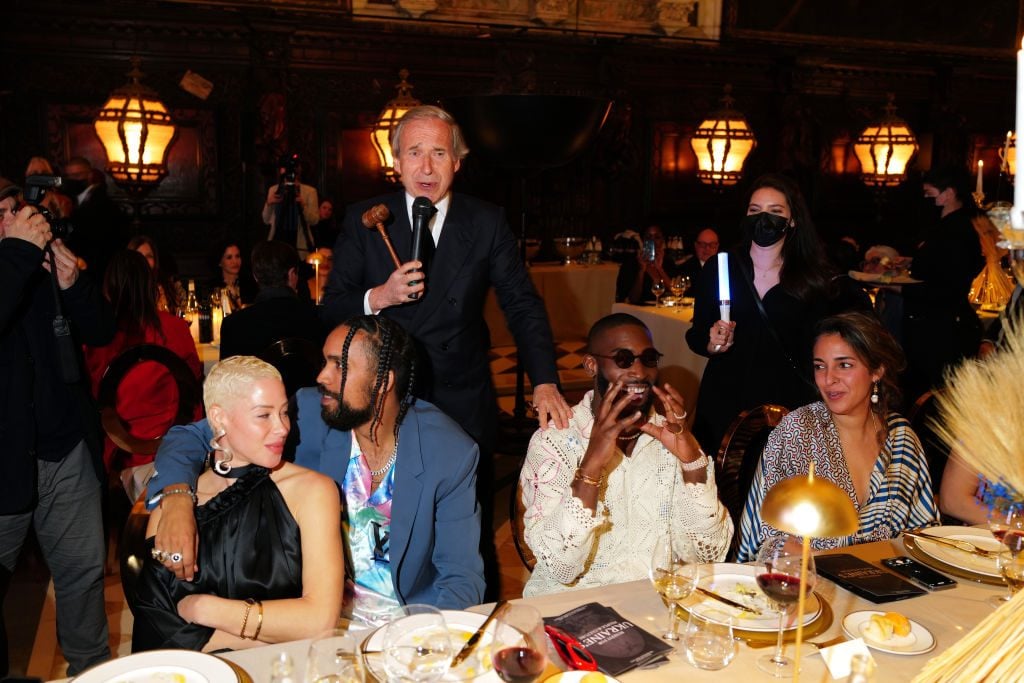
Even among the most glitzy events, the war was never far from anyone’s minds.

Simon de Pury

Every month in The Hammer, art-industry veteran Simon de Pury lifts the curtain on his life as the ultimate art-world insider, his brushes with celebrity, and his invaluable insight into the inner workings of the art market.
My head is still spinning with the many impressions garnered during the opening week of the 59th Venice Biennale.
Its artistic director Cecilia Alemani put together one of the most exciting editions I have ever visited. Besides the official program of the Biennale, you get the feeling that every single Venetian Palazzo is staging some cultural event. The choice between countless openings programmed for every hour in the day can at times be so overwhelming that, instead of running in all directions like a madman, I am very tempted to simply chill next to my favorite swimming pool in the world, at the Hotel Belmond Cipriani. With the wet April weather instead of the customary heat experienced during the past biennales that would usually open in May or June, I luckily managed to avoid succumbing to that temptation.
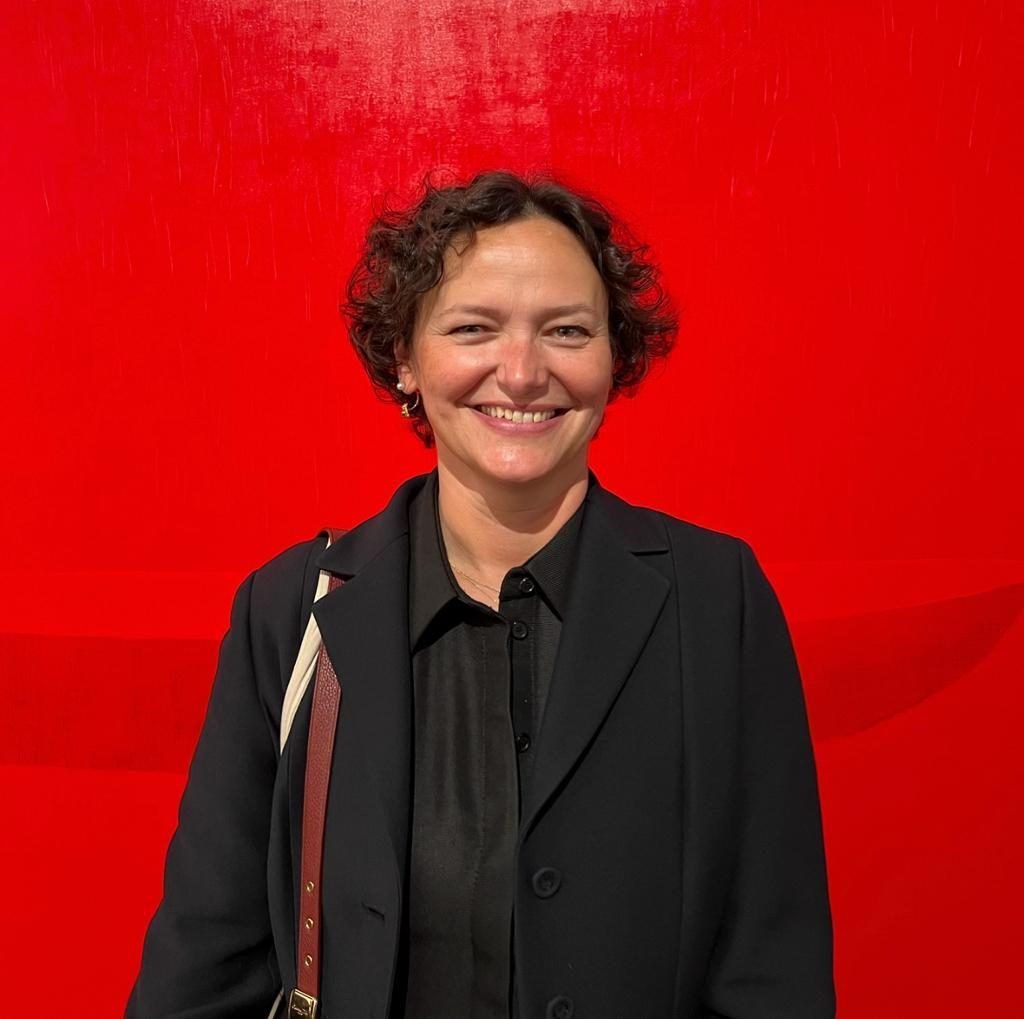
Cecilia Alemani Artistic Director of the 59th Venice Biennale Photograph by Simon de Pury.
With the gradual easing of pandemic related travel restrictions, it felt that most of the members of the permanently traveling circus that is the art world had shown up in person. The result is that securing a room anywhere is no small feat. This was always the case during the opening weeks. Long gone however are the days when despite all hotels being fully overbooked, I considered it a fun challenge to myself to show up in Venice without any reservations, intrigued where fate or rather luck would lead me to spend the nights. Now I book and pay a deposit months in advance to avoid any of that.
Venice felt a bit like a gigantic family or school reunion and everyone seemed genuinely happy to be experiencing art in the flesh as opposed to on a screen. Yet the big black cloud that was on everyone’s mind is the horrific war that is raging on in Ukraine and that has now entered its third month. The danger is that as things drag on we shut ourselves off to the inhumanity of it all and numb our minds.
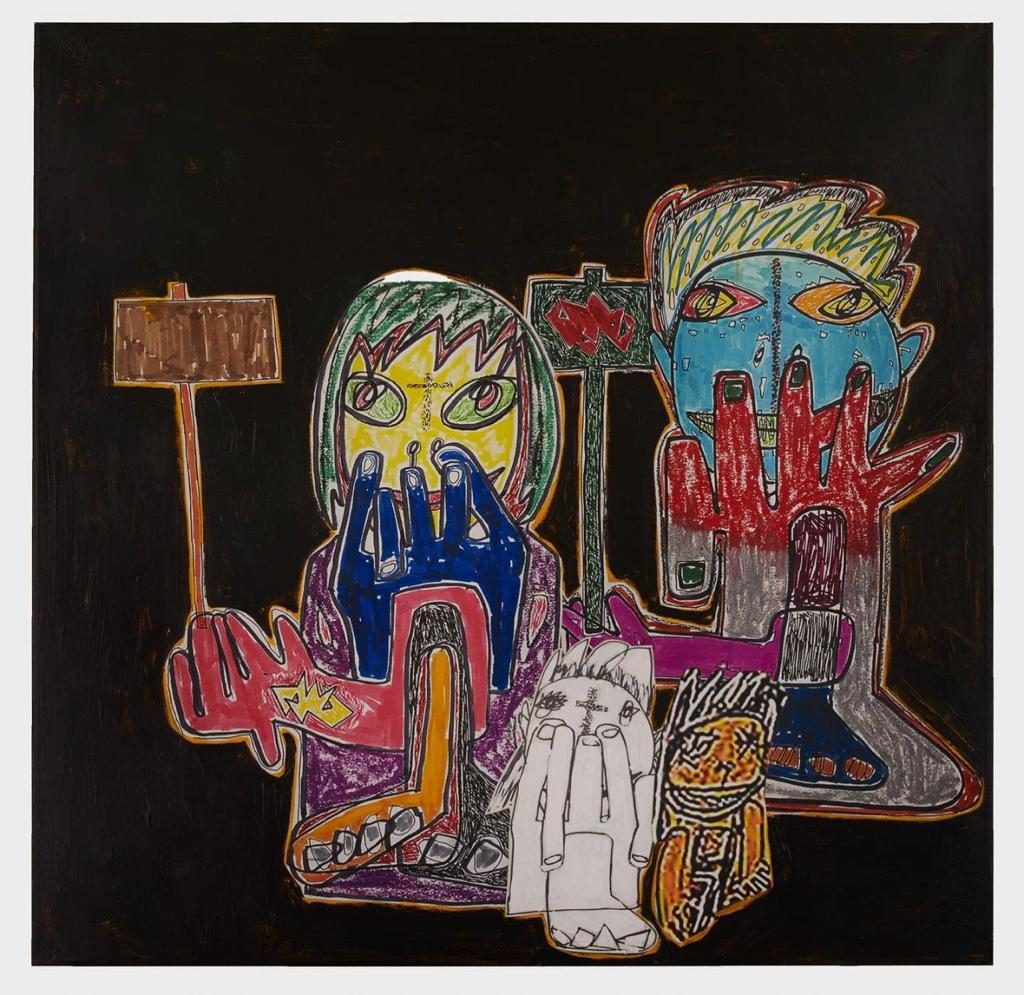
Richard Prince, Untitled (High Times) (2021). Courtesy the artist. Donated by Richard Prince for the benefit auction for Ukraine’s people and culture.
In an impromptu act of solidarity, likeminded members of the global art family like Peter Brant Jr., Francesca Thyssen-Bornemisza, Marc Glimcher, Larry Gagosian, Lauren Taschen, Hans-Ulrich Obrist, Klaus Biesenbach, Ivy Getty, Mikolaj Sekutowicz, and many others, organized a benefit for Ukraine’s people and culture. It was held at the Scuola Grande di San Rocco. The above individuals secured last minute donations by generous artists that were still coming in on the day of the event, Thursday April 21, and continue to be offered following the event.
I was asked to conduct the auction on the night. Before any auction I conduct I am as nervous as if it was the first one ever. This is despite the fact that I have led a few auctions by now. Before the sale in Venice I was at least ten times more nervous than usual. Great works by a.o. Richard Prince, Louise Nevelson, David Salle, Julian Schnabel, Claudia Comte, and Francis Alÿs had been generously donated. None of these works were physically there, but more importantly none of the guests arriving that night knew in advance what was going to be sold. This complete lack of pre-marketing wasn’t exactly reassuring.
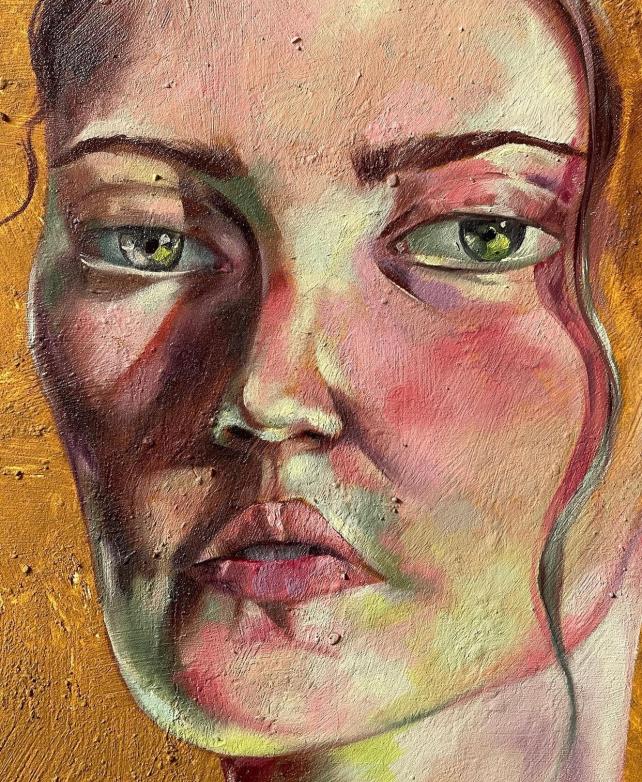
Alina Zamanova self-portrait (detail) done with Ukrainian soil on day 31 of the war. Photograph by Alina Zamanova
The auction started with a work by Ukrainian artist Maria Prymachenko, which was donated by the artist’s great granddaughter. One of the first works you see when you walk into the Biennale is a Prymachenko that Cecilia Alemani prominently placed near the entrance. This is particularly poignant when you bear in mind that several works by this self-taught artist, who was being admired by Pablo Picasso, were saved from the flames of a museum in the region of Ivankiv after it was hit on the third day of the war. A heated bidding battle between French Canadian collector François Odermatt and Egyptian entrepreneur Naguib Sawiris made the price rapidly soar to €110,000 ($117,400) which is four times the previous record for a work by the artist sold at auction.
The auction raised more than €1.2 million ($1.3 million) for humanitarian efforts in Ukraine. The funds will be distributed to organizations including Museums for Ukraine, the Maria Prymachenko Foundation, the Ukrainian Emergency Pavilion, and Ukrainian Emergency Art Fund. My favorite work in the auction was a self-portrait by Alina Zamanova. It was made with Ukrainian soil by the artist while she was sheltering from the bombs on the 31st day of the war. Her Instagram account is a stirring diary of the artist’s fear, anguish and despair at what is unfolding in her country. Her work had never appeared at auction before. I had given it an estimate of €8,000-€9,000 ($8,500–$9,600); it sold for €35,000 ($37,400). Besides the evident quality of her work, the moving speech she filmed on her phone that was aired to the guests helped energize the bidding.
More than 45 works have been donated by artists including Monica Bonvicini, Anish Kapoor, and Urs Fischer since the sale, and are part of an online auction that is accessible on http://ukrainebenefit-auction.ikona.one and ends on May 8.
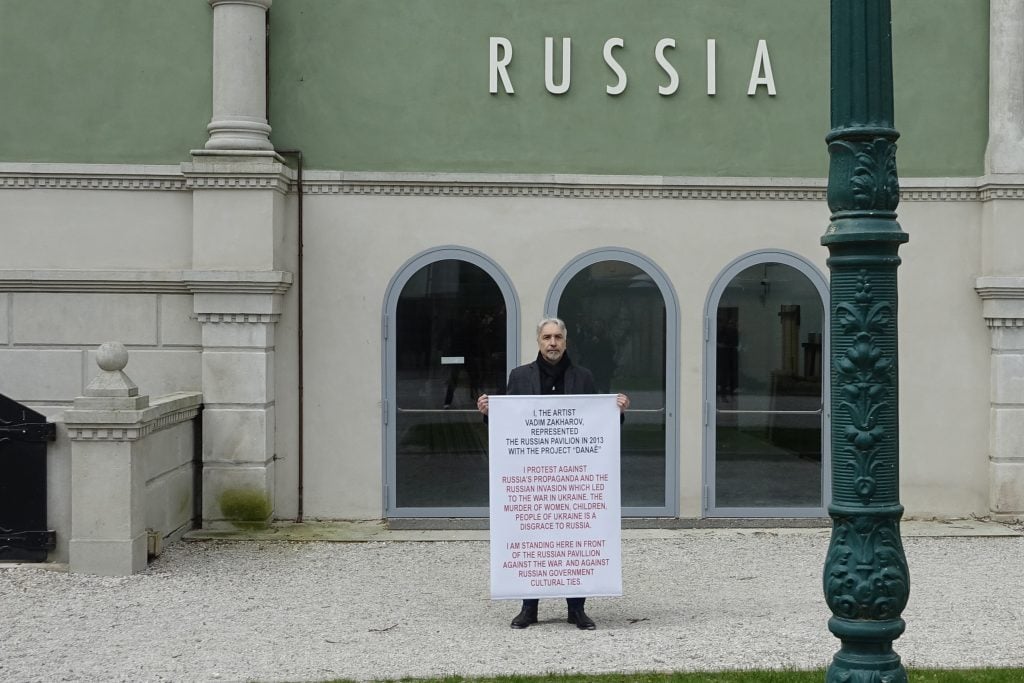
Vadim Zakharov statement front of the Russian Pavilion at the Venice Biennale in 2022. Photo by Konstantin Akinsha, courtesy the artist. Text reads: “I, the artist Vadim Zakharov, represented the Russian Pavilion in 2013 with the project “DANAË” I protest against Russia’s propaganda and the Russian invasion which led to the war in Ukraine. The murder of women, children, people of Ukraine is a disgrace to Russia. I am standing here in front of the Russian pavilion against the war and against Russian government cultural ties.”
The day after the auction I read Scott Reyburn’s interesting article in the NYT, which commented on “A Surreal Feel at a Wartime Venice Biennale.” In it, I read about the silent protest action that Russian artist Vadim Zakharov had staged outside the shuttered Russian pavilion in the Giardini. I had missed it since he was swiftly removed by a security guard after unfolding a banner condemning the Russian invasion. The banner itself got confiscated. Zakharov had represented Russia in the 2013 Biennale, during which his works were exhibited in the very pavilion that was now shut. While Zakharov now lives in Berlin it is nevertheless an act of courage for which he deserves respect. As a young man in Moscow, during the Cold War, Zakharov had worn a patch covering one of his eyes for several months. He documented it with a number of photographs saying that he had wanted to experience what the world looked like when you only had a one-sided view of it. I fell in love with his paintings and selected some for the seminal auction of Russian contemporary art that Sotheby’s held in Moscow on July 7, 1988.
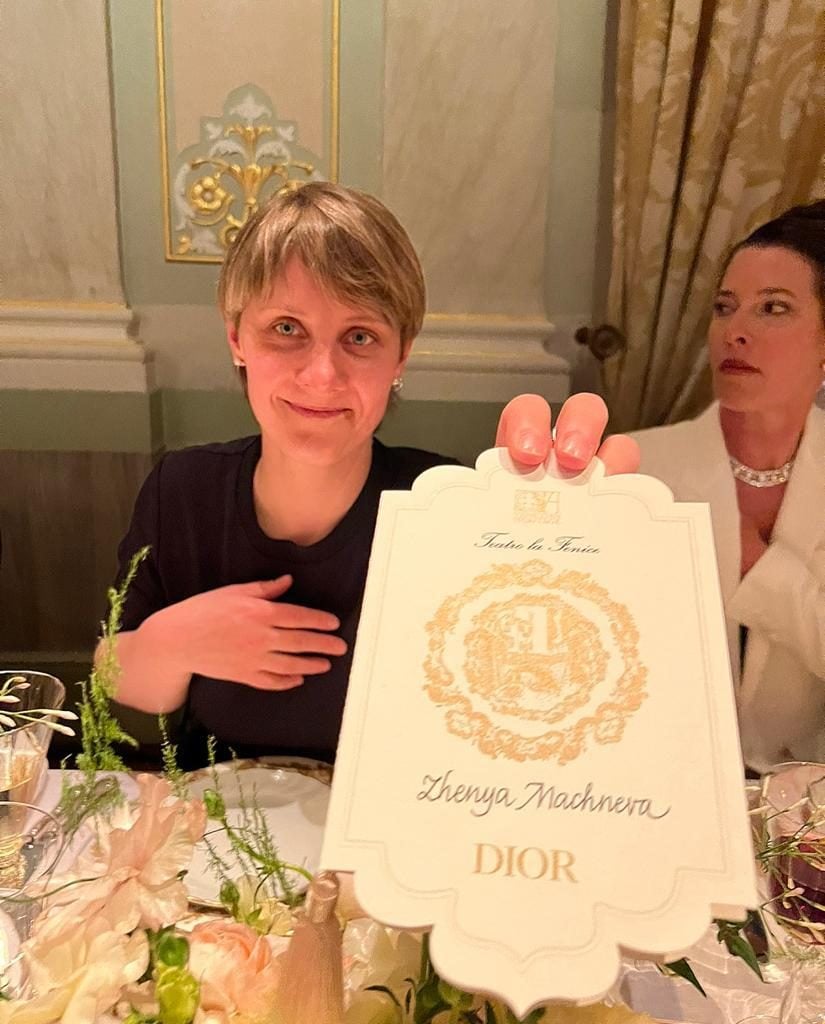
Russian artist Zhenya Machneva at the Venetian Heritage Dinner. Photograph by Simon de Pury.
At the Venetian Heritage dinner that was sponsored by Dior and held at the Fenice, I had the pleasure of being seated opposite Russian artist Zhenya Machneva, whose work is exhibited at the Arsenale.
Last October was the last time I was in Kyiv. It was as a member of the jury for the 2021 Miss Ukraine contest, a very tough job as you can well imagine! Like every visit to Kyiv (my first was in 1983), and every visit to Moscow (my first in 1982), I had a memorable time. In both cities I did so many late-night artist studio visits. This war between brothers is beyond heartbreaking. While we rightly celebrate Ukrainian culture which is under attack, we must not silence the voice of Russian artists. It is only culture, art, music, cinema, theater, literature, fashion, and sport that can build bridges between people of different backgrounds, origins, skin colors, religious beliefs, financial conditions, and sexual orientations.
Simon de Pury is the former chairman and chief auctioneer of Phillips de Pury & Company, former Europe chairman and chief auctioneer of Sotheby’s, and former curator of the Thyssen-Bornemisza Collection. He is now an auctioneer, curator, private dealer, art advisor, photographer and DJ. Instagram: @simondepury